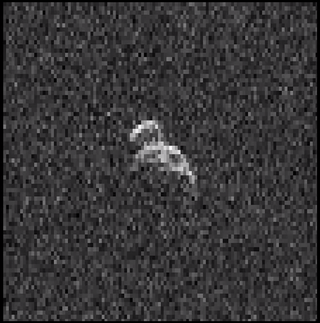Huge Peanut-Shaped Asteroid Buzzes Earth in NASA Video
A large asteroid shaped like a cosmic peanut zipped safely by Earth this month, and a new NASA video retells the entire space rock encounter as it happened using impressive radar images.
Scientists using NASA's Deep Space Network Goldstone antenna in California tracked the near-Earth asteroid 2006 DP14 using radar imaging as the space rock passed within 2.6 million miles (4.2 million kilometers) of our planet on Feb. 12. The new radar images show that 2006 DP14 is about 1,300 feet long (400 meters) and 660 feet wide (200 m). NASA created a video of asteroid 2006 DP14's Earth flyby with the Goldstone radar images.
The asteroid is known as a "contact binary" because the two halves of its peanut shape seem to be touching and moving through space together. 2006 DP14 made its closest approach to Earth on Feb. 10 when it traveled about 1.5 million miles (2.4 million km) from the planet's surface, NASA officials said. Scientists then observed the asteroid on Feb. 12 from 12:03 a.m. EST to 2:27 a.m. EST (0503 GMT to 0727 GMT). [See photos of potentially dangerous asteroids]

"Radar is a powerful technique for studying an asteroid's size, shape, rotation state, surface features and surface roughness, and for improving the calculation of asteroid orbits," NASA representatives wrote in a statement. "Radar measurements of asteroid distances and velocities often enable computation of asteroid orbits much further into the future than if radar observations weren't available."
Earlier studies have shown that about 10 percent of near-Earth asteroids larger than 650 feet (200 m) have contact binary shapes, NASA officials said.
Comets and asteroids are considered near-Earth objects (NEOs) of they fly within about 28 million miles (45 million km) of Earth's orbital distance, NASA officials have said.
Near-Earth objects can be many shapes and sizes. The asteroid 1036 Ganymed is the largest NEO discovered by scientists so far. That space rock is about 25 miles across (41 km).
Sign up for the Live Science daily newsletter now
Get the world’s most fascinating discoveries delivered straight to your inbox.
So far, scientists have found more than 90 percent of NEOs larger than 0.6 miles (1 km) in size. These huge space rocks could create global problems if one impacted Earth, but none of these catalogued NEOs seems to be on a trajectory that would lead it to smack into the planet.
"In addition to the resources NASA puts into understanding asteroids, it also partners with other U.S. government agencies, university-based astronomers, and space science institutes across the country that are working to track and understand these objects better, often with grants, interagency transfers and other contracts from NASA," NASA officials said.
Follow Miriam Kramer @mirikramer and Google+. Follow us @Spacedotcom, Facebook and Google+. Original article on Space.com.













